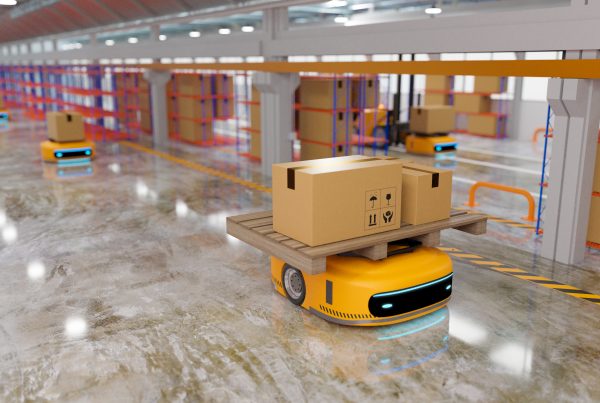机器人 & 仓储自动化
2022-07-07
控制环境农业:机器人供应商的市场沃土

Blake Griffin
Blake是自动化系统、工业数字化和非道路移动机械电动化方面的专家。自2017年加入 Interact Analysis 以来,他撰写了有关低压交流电机驱动器、预测性维护和移动液压市场的深入报告。
Interact Analysis attended the Greentech conference in Amsterdam a few weeks ago. The Greentech conference is amongst the largest gathering of controlled environment agriculture (CEA) tech vendors in the world. The conference is hosted in the heart of the CEA world, the Netherlands, and showcases everything from advancements in lighting through to fully automated solutions for transplanting, planting, grading, harvesting, and packaging.
The Dutch model for indoor agriculture has been the standard across the controlled environment agriculture landscape. In a region where sunlight is limited during much of the year, a thriving harvest depends on the ability to provide artificial sunlight during periods of prolonged darkness. This is achieved through tightly controlled greenhouses which can be spotted across rural areas of the Netherlands. Controlling humidity, water intake, and lighting, growers have achieved a new efficiency in growing certain crops using automated greenhouses. So much so that the Netherlands – the 134th country by physical size – is the world’s second largest exporter of agricultural produce.
Increasingly, the topic of vertical farming is being discussed as an alternative to traditional controlled environment agriculture methods. Companies like Aerofarm, Bowery Farms, Infinite Acres, and Plenty amongst many others, have raised a significant amount of capital under a value proposition aimed at tackling problems such as increasing population, water scarcity, and topsoil degradation. Between these four companies, nearly $2 billion of funding has been raised. Despite this funding, the vertical farm market remains nascent. However, the fundamentals driving this market are too large to ignore. Both vertical farming and traditional automated greenhouses are set to see rapid growth over the next decade as humanity works to fill its breadbasket amidst a strong headwind.
The Drivers Towards Controlled Environment Agriculture Are Too Large to Ignore
The world has been staring down the barrel of an inevitable problem: climate change. With this, comes longer droughts resulting in reduced water availability and further degradation of the topsoil which has already been damaged by current agricultural methods. In a report published by the BBC in association with Corteva Agriscience, over the last 100 years, the fertile topsoil in Iowa has reduced from a depth of 14-18 inches, to 6-8 inches. The reduction of topsoil is a global problem that is set to get worse with increasing temperatures and shifting weather patterns.
This issue arises at a time when the number of mouths to feed is projected to increase by nearly 1bn people over the next 15 years according to the World Bank. To avoid widespread famine, the world must adapt its agricultural practices to be more efficient and sustainable. Controlled environment agriculture has the potential to provide this.
Controlled environment agriculture enables a more efficient use of key resources. Using carefully controlled water, air, and lighting systems, these growing environments can produce food at a consistent rate and can more easily eliminate pests and disease from plants. The LEDs used in these facilities can be tuned to produce light that optimizes the plants’ photosynthesis process and a range of nutrient delivery systems can reduce the amount of water needed per plant. This leads to more food being grown more quickly and more efficiently than traditional agricultural methods.
If It’s So Great Then Why Isn’t All Food Grown This Way Already?
As with any great innovation, it takes time for the enabling technology to achieve economies of scale. Historically, the high price of lighting has been a barrier to the ROI of controlled environment agriculture. Fortunately, this has changed over the last decade as the cost of LED lights have fallen dramatically. Despite this, the energy efficiency of these lights has largely plateaued. Resultingly, the operational costs associated with lighting indoor agricultural environments can be a major barrier to adoption.
This barrier is particularly evident for vertical farms whose operations top traditional automated greenhouses both in terms of number of lights and operating hours of lights. The energy draw from vertical farms also calls into question the sustainability of the practice. The amount of water saved through more efficient growing processes is potentially offset by the additional water needed at powerplants to support higher energy use. As such, the growth of vertical farming is tightly coupled to the broader green transition of our energy grid. Fortunately, traditional automated greenhouses, unlike vertical farms, can rely on the sun during the day which makes their case immediately more pragmatic.
Other barriers exist also. Similarly to warehousing and manufacturing, labor availability and turnover for low skill jobs like harvesting has been an increasingly difficult problem to address and it is eating into the bottom line of growers. Just as in manufacturing and warehousing, one solution to this problem is to remove the need for labor through the automation of processes within the greenhouse and our observations at Greentech were that increasingly automated solutions are beginning to sprout.
Agriculture Robotics: A Fresh Landscape for Robotic Suppliers
A number of vendors were displaying robotic solutions at Greentech this year. These solutions ranged from newly introduced mobile harvesting robots, to more traditional stationary robots used for processes like transplanting, grading, and sorting. Organifarms won Greentech’s innovation award for its new strawberry harvesting robot which was officially released at the show. Other important displays concerning harvesting robotics at the show included a partnership between solution provider Ridder and tomato harvesting robotics manufacturer MetoMotion. Traditional industrial robotics suppliers also had a small presence. A Denso branded harvesting robot offered by solution provider Certhon was being demoed at its booth. Additionally, Crux Agribotics displayed several machine types made in partnership with ABB aimed at automating a variety of processes.
Despite a number of vendors offering these solutions, the scale at which they are being sold remains small relative to the sale of robotics in other, more mature applications. The number of newly announced robotic solutions should, however, be taken as a signpost for the direction the market is headed. An increasing rate of automation within the controlled environment agriculture space coupled with the rapid growth the landscape is likely to see over the next decade makes this application ripe for robotic sales.
We are not the only ones who are monitoring this either. At Greentech we observed several traditional automation suppliers in attendance. These companies are the type you would typically associate with automating solutions within manufacturing or warehousing. While these companies did not have a booth at the show, they were walking the floor getting a feel for the progress automation has made over the last year within the space. It would not be a surprise for us to see these large multinational corporations begin displaying at Greentech in the near future; another indication that this market is approaching a growth phase.
Final Thoughts
At Interact Analysis we cover the mobile robotics market heavily. These robots are used primarily in warehousing applications. We began covering the market when it was in its infancy and it has since begun growing at a tremendously fast rate. The agricultural robotics industry shares many of the same qualities that the mobile robotics market showed 5 years ago: emerging startups with novel robotic types, a large established potential installed base, and fundamental drivers of growth which are inevitable. In mobile robotics space, the driver was the proliferation of ecommerce. In the controlled environment agriculture space, the driver is much more existential.


